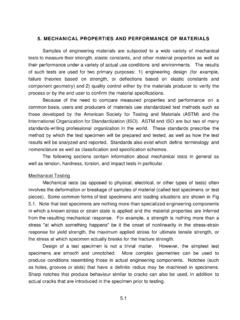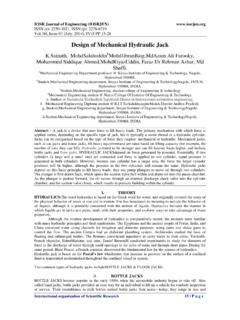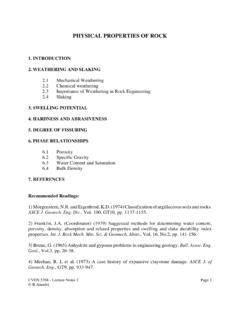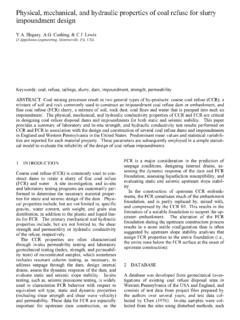Transcription of Design of modern hydraulic tank - IJSIMM
1 Int j simul model 11 (2012) 2, 77-88 ISSN 1726-4529 Original scientific paper (2) 77 Design OF modern hydraulic TANK USING FLUID FLOW SIMULATION Ti , V.*,** & Lovrec, D.** *OLMA , Poljska pot 2, SI-1000 Ljubljana, Slovenia **University of Maribor, Faculty of Mechanical Engineering, Smetanova 17, SI-2000 Maribor, Slovenia E-Mail: Abstract hydraulic power units are one of the most commonly used power sources in industry. The progress in recent years has offered high efficiency and reliable hydraulic components, yet the hydraulic tank Design is often neglected part of the development. The paper presents the development of industrial 400 litre hydraulic tank. In order to reduce oil swirling and improve stability of fluid flow, CFD simulations of oil flow inside hydraulic tank were made. Several variations of new hydraulic tank designs are compared with standard industrial tank.
2 Furthermore, to achieve steady flow through the entire reservoir and reduce the phenomenon of oil swirling, newly-developed diffuser is used. Consequently a full scale hydraulic power unit was built according to obtained results. (Received in September 2011, accepted in February 2012. This paper was with the authors 1 month for 1 revision.) Key Words: hydraulic Tank, Fluid Flow, Simulation, Design 1. INTRODUCTION hydraulic power units are types of equipment, from which the user expects an energy-saving and reliable operation with minimum maintenance problems, even in cases when operated within a basic industrial environment. The potential consequences for the user of any bad decisions made during its Design can be a lifetime of high operating and maintenance costs. At the same time, hydraulic power units represent those parts of hardware which operate within different types of technology: mechanical engineering, electricity, electronics, informatics, and sensorics.
3 Denying or ignoring one of those elements at any time leads to the already mentioned lack of functioning by the entire system. In its development, there is an urgent need to take into account all the specific knowledge from these areas of technology. The Design of an appropriate hydraulic power unit follows the development of a hydraulic tank as one of the major building blocks, which is primarily intended for the storage of liquid, and maintaining its properties. The creation of a hydraulic tank definitely needs greater attention, as its correct Design has an influence on the operation of the entire hydraulic system. Most common mistakes made during tank Design , are only seen during its operation over time, and can cause many problems for users and maintenance personnel. It is necessary to pay special attention thus trying eliminating air and condensate, and at the same time, identifying flow-patterns in the tank and thus trying to stabilize the liquid [1, 2].
4 The help of virtual engineering can be used, when designing a modern hydraulic tank. hydraulic components and devices are typically parts of the control and drive systems. Due to their inherent transient operating conditions, and the transformation of fluid flow into the mechanical movement they pose a challenge for virtual engineering. Unsteady fluid-flow, movement and deformation within the simulation domain, and physical phenomenon such as cavitation, place great demands on the simulation tools [3]. Ti , Lovrec: Design of modern hydraulic Tank Using Fluid Flow Simulation 78 Available computational power has increased considerably and more capable simulation tools for complex physics are now available. During the process of Design and development, the demands on robust and reliable products have to be considered together with multiple Design restrictions parameters of influence. All these aspects can only be fulfilled by the integration of CAD and CFD tools [3].
5 The advantage of using simulation techniques in the field of hydraulic tank Design will be explained by illustrating the results of on-going research tasks. 2. FUNCTIONS OF A hydraulic TANK A hydraulic tank is an important part of a hydraulic power unit and represents the heart of the hydraulic system. It needs to perform several functions, among which the most are summarized below. Primary function The primary function of any tank is the storage of substances or fluids. In our case, the tank must retain the total quantity of hydraulic oil, which is located in the hydraulic system. In addition the hydraulic tank should compensate for oil level oscillation due to temperature changes or possible leakage from the system. Cooling of hydraulic fluid As a result of losses arising from the transformation of energy in the hydraulic components, the temperature of the hydraulic fluid rises when passing through the system.
6 In addition to an additional cooling system, the tank itself also emits a large proportion of heat through the surfaces in the surrounding area. The radiated power of heat primarily depends on the sizes of those areas in contact with the surroundings, and the temperature difference between the hydraulic oil and the surrounding area. When designing the hydraulic tank, a designer should properly form the tank in order to increase the size of the area through which heat is emitted - thus providing better natural cooling (cooling ribs). Elimination of air One of the long-term risks of the hydraulic system is the formation of air bubbles, which can be detected by the noisy operation of components. They usually occur at pressures below the saturation pressure, leakage points on the system, or by an excessive swirl of oil at the return line. A hydraulic tank should be designed to provide optimum air extraction from the oil. The usual consequences are: - destruction of pumps due to the emergence of cavitation on the inlet side, - imprecise movements caused by increased fluid compressibility, - temperature increase of oil, - accelerated aging of oil, - accelerated destruction of seals.
7 Elimination of condensate Condensation is a result of temperature changes in tank s hydraulic fluid. Any non-binding water in the oil has an adverse impact on the hydraulic system, as it accelerates the corrosion of metal parts, reduces the lubricating properties, and causes rapid aging of the oil. The minimum proportion of water is bound with the oil, resulting in the formation of emulsion. Ti , Lovrec: Design of modern hydraulic Tank Using Fluid Flow Simulation 79 This residue is excreted as loose water which is, in the case of slow-flows, retained in the lowest part of the tank (water has a higher density than hydraulic oil). Disposing of dirt All the dirt cannot be removed by fine filtration. After a long operating period they accumulate at the bottom of the tank. A designer must provide for the pumping of clean oil by using the proper installation of suction and return tubes. This practice seeks to avoid this problem by cutting off the ends of flow tubes at an angle of approximately 45 (turned away from each other), thus providing a smaller interactive effect.
8 This problem can also be solved with the use of an additional wall, separating the suction and return sections of the tank. Other functions During the life-cycle of a hydraulic power unit, maintenance interventions are carried out, thus the tank must be designed to facilitate maintenance. It should be possible to access individually built-in components. Therefore the tank should have several cleaning openings for accessing the inside of the tank, through which it can be examined and cleaned. Finally, vibration and sound should be kept to a minimum. modern designed components are often already optimized by the manufacturer, and produce much less noise than components of older generations. 3. USE OF VIRTUAL ENGINEERING IN HYDRAULICS Simulation techniques are becoming more and more established during the Design and development processes regarding new products [4, 5]. Driven by developments in high technology industries such as aerospace and automotive also use these methods for estimating robustness and reliability.
9 They also represent an important part of innovation processes [6]. Hydraulics, as more traditional parts of mechanical engineering, is produced by small and middle range companies. They are mostly suppliers of machine tools manufacturers, the process engineering and automotive industries. Over the past decade, there has been a trend backwards from delivering single components to the Design of assemblies or complete functional units. An additional trend is the change from fluidic components only to complex mechatronic systems, including units for signal conditioning, electromechanical actuators, controller electronics, and sensors. Interaction between components and sub-assemblies are no longer negligible. Within the engineering aura, hydraulics and pneumatics have dramatically changed and become more complex and multidisciplinary. The operational conditions for hydraulic and pneumatic systems pose a challenge for virtual engineering [3].
10 In hydraulics, you have to deal with some extremely nonlinear effects: Many flow processes are within transition ranges, from laminar to turbulent. In hydraulics we have cavitation and aeration at low pressure. Therefore multi-phase models have to be developed, and additional material data needed. These topics will become increasingly important due to certain on-going trends like: - miniaturisation and functional integration of components and systems, - needs for energy consumption and noise reduction, - increasing demands in regard to more reliable, robust, and safe products. These all result in a discrepancy between the complexity of physics and the modelling of real operational conditions in hydraulics on the one hand, and the limited capacity in research and development of mainly small companies in the fluid power industry, on the other hand. Ti , Lovrec: Design of modern hydraulic Tank Using Fluid Flow Simulation 80 To date there are several known researches (simulations) of fluid flow, and optimization studies in hydraulic components and tubing.










